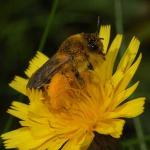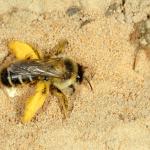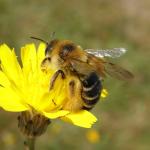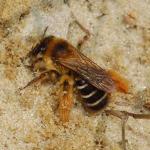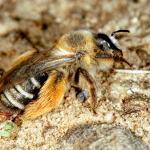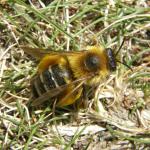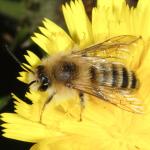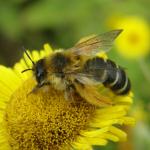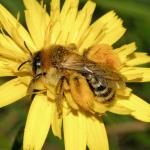Apis altercator HARRIS 1780; Andrena hirtipes FABRICIUS 1793; Andrena plumipes PANZER 1797; Melitta swammerdamella KIRBY 1802; Dasypoda graeca LEPELETIER & SERVILLE 1825; Dasypoda panzeri SPINOLA 1838; Dasypoda villosa LEPELETIER 1841; Dasypoda minor PÉREZ 1903 (nec MORAWITZ 1871); Dasypoda plumipes auct. (dont FRIESE 1901)
The female of this species is one of the more attractive and distinctive bees which occur in Britain, the extremely long, golden pollen-collecting hairs on the hind tibiae being particularly notable. D. hirtipes is the only member of its genus which occurs in Britain.
Southern England and Wales, northwards to Merionethshire and Norfolk; also recorded from Guernsey and Jersey. Widely distributed in Europe, from southern Finland south to Spain and the Canary Islands, and east to Turkey, Ukraine and Armenia. It occurs in North Africa including Egypt.
A Nationally Notable (Nb) species.
Sandy soils, particularly on heathlands and coastal dunes.
Univoltine; late June to the end of August or the beginning of September.
Females mainly excavate their nests in sandy, sparsely vegetated, level soil. Some sites contain nest aggregations of great extent. The main burrow is very long (8-60 cm) and is excavated at an oblique angle, resulting in a ‘fan’ of spoil to one side of the entrance. Cells are built at the ends of laterals which arise from the distal portion of the main burrow. In Denmark (and possibly in Britain), nest excavation usually takes place in the afternoon, females rarely leaving their burrows after mid-day or early afternoon (Lind, 1968). During excavation the hind tibial scopa is used as a brush to clear soil from the burrow entrance (Saunders, 1908; G R Else, pers. obs.). Nests are described by Müller (1884), Malyshev (1927) and Lind (1968). The early stages have been described by Müller (1884) and Rozen & McGinley (1974).
This bee is especially associated with yellow Asteraceae flowers. A record of a visit to an onion (Allium sp.) probably refers to a nectar source. Flower visits are more often observed in the morning as most of the blooms that both sexes visit tend to close from late morning onwards.
Sarcophagid flies in the genus Miltogramma seem to be important parasitoids in the nests of this bee (Müller, 1884; Gardner, 1901; Pape, 1987).
Profile written: 1998
Updated: January 2011


